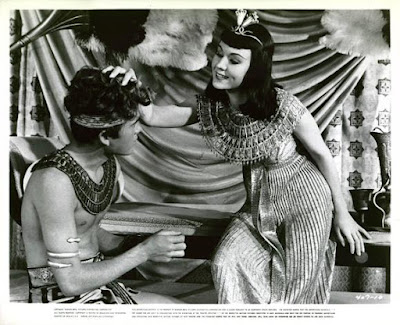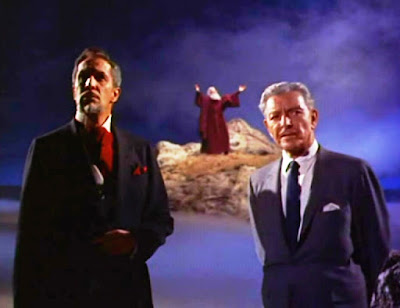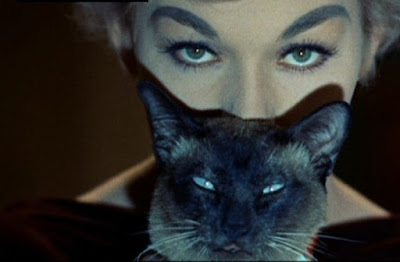Mais estrelas que há no céu: com este lema eram anunciados os filmes “all-star”. Estes eram filmes com um elenco de dar inveja, e entre os muitos produzidos podemos mencionar “Grande Hotel” (1932), “Jantar às Oito” (1933), “Seis Destinos” (1942) e “A Conquista do Oeste” (1952). Se um bom elenco reflete na qualidade de um filme, isso significa que um filme “all-star” não pode ser ruim, certo? Errado. Vamos dar uma olhada em um filme “all-star” que deu muito errado: “A História da Humanidade” (1957).
More stars than there are in Heaven: with this motto the “all-star” movies were advertised. These were movies with an impressive cast, and among them we can mention “Grand Hotel” (1932), “Dinner at Eight” (1933), “Tales of Manhattan” (1942) and “How the West Was Won” (1952). If a good cast reflects in the quality of the movie, this means that an “all-star” movie can’t be bad, right? Wrong. Let’s take a look at an “all-star” movie gone terribly wrong: “The Story of Mankind” (1957).
A trama até que é interessante. Depois do desenvolvimento de uma arma denominada Super H-Bomb – ou seja, uma bomba de hidrogênio -, seres celestiais organizam um julgamento no espaço sideral para decidir o destino da humanidade. Será que a humanidade deveria ser salva ou os seres celestiais deixarão os homens destruírem uns aos outros? Para decidirem, os juízes vão ouvir os argumentos do Espírito do Homem (Ronald Colman), que tentará proteger a humanidade, e do Diabo (Vincent Price), que tentará provar que a humanidade sempre foi má e merece ser extinta. Nos 90 minutos seguintes, haverá um desfile de participações especiais e algumas mortes ridículas.
The plot is actually interesting. After the development of a weapon named Super H-Bomb – that is, a hydrogen bomb –, celestial beings call for a tribunal in outer space to decide the fate of mankind. Should mankind be saved from itself or will the celestial beings let men destroy other men? In order to decide, the judges will hear arguments from the Spirit of Man (Ronald Colman), who will try to protect mankind, and from the Devil (Vincent Price), who will try to prove that mankind has always been evil and deserves to be erased from Earth. In the following 90 minutes, you’ll be served a parade of special guests and also some ridiculous onscreen deaths.
O filme não é muito bondoso para com as mulheres notáveis da história. Ele retrata Helena de Troia como uma femme fatale fútil, Cleópatra como ladra (e também fútil) e Maria Antonieta como uma tirana sem coração. Joana D’Arc (interpretada por Hedy Lamarr) é uma heroína, mas o Diabo usa o caso dela para provar que as pessoas são más porque traem outras pessoas, como Joan foi traída por compatriotas francesas. Mulheres são comumente apagadas da história, e é uma pena que, quando elas são mencionadas, são retratadas como personagens pouco complexas.
The movie is not very kind to the notorious women of history. It portrays Helen of Troy as a futile femme fatale, Cleopatra as a pickpocket (also futile) and Marie Antoinette as an inconsiderate tyrant. Joan of Arc (played by Hedy Lamarr) is a heroine, but the Devil uses her case to prove that people are evil because they betray other people, as Joan was betrayed by her fellow Frenchmen. Women are often erased from history, and it’s a shame that, when they are acknowledged, they are portrayed as less-than-complex characters.
A maioria dos momentos de bondade mostrados pelo Espírito do Homem tem a ver com religião. Isso inclui a revelação dos dez mandamentos para Moisés, os primeiros católicos rezando nas catacumbas em Roma, os monges mantendo a palavra de Deus viva na Idade Média. Todo esse discurso católico é estranho, e ainda mais estranho considerando que o filme diz que o julgamento é no espaço sideral, não no Céu. Nestes momentos, o filme se torna pregador, soando mais como uma lição de moral que uma obra de entretenimento.
Most of he moments of goodness shown by the Spirit of Man are connected with religion. This includes the reveal of the ten commandments to Moses, the first Catholics praying in the catacombs in Rome, the monks that kept God’s word alive during the Middle Ages. All this Catholic speech is odd, and even odder considering that the movie says that the courtroom is in outer space, and not Heaven. In these moments, the film becomes too preachy, sounding more than a moral lesson than a piece of entertainment.
“A História da Humanidade” apresenta apenas a história eurocêntrica, sendo inclusive “anglocêntrica” quando conta, por exemplo, que a lei e a ordem foram trazidas de volta ao mundo quando o rei John assinou a Magna Carta no século XIII. Ao seguir esta visão, o Diabo apresenta um bom argumento, por exemplo, quando fala sobre a destruição trazida pelo colonizador para a América, com o massacre dos nativos. O Diabo mais uma vez tem razão quando o Espírito do Homem tenta mostrar que o colonizador inglês é um cavalheiro, e o Diabo o recorda da escravidão.
“The Story of Mankind” presents only Eurocentric history, even being “anglocentric” when it tells, for instance, that law and order were brought back to the world when king John signed the Magna Carta in the 13th century. By following this vision, the Devil makes a point, for instance, when he talks about the destruction brought by the colonizers to America, with the slaughter of the natives. The Devil also scores when the Spirit of Men tries to paint English colonizers as true gentlemen, and the Devil reminds him of slavery.
Ronald Colman foi uma escolha perfeita para interpretar o Espírito do Homem e nos defender. Um ator fantástico, Colman interpretou muitos personagens honrados, como o protagonista de “A Queda da Bastilha” (1935). Vincent Price também foi a escolha perfeita para fazer o Diabo: suave e fria, sua persona cinematográfica combina com sua interpretação de um diabo bonitão e ultrarracional.
Ronald Colman was a perfect choice to play the Spirit of Man and defend us all. A superb actor, Colman often played honored characters, like the lead in “A Tale of Two Cities” (1935). Vincent Price was also perfectly cast as the Devil: suave yet cold, his onscreen persona matches this portrayal of a handsome and intellect-driven devil.
A premissa de “A História da Humanidade” é até bem intelectual: o homem é intrinsecamente bom ou mau? Esta é uma questão feita e refeita há séculos, uma questão que dividiu filósofos com o passar dos séculos: Thomas Hobbes acredita que somos intrinsecamente maus, Jean-Jacques Rousseau acha que os humanos são bons. Sociedades complexas modernas – e por “modernas” eu quero dizer sociedade como as que emergiram na Mesopotâmia por volta de 3000 a.C. - são as sociedades em que líderes tirânicos podem emergir – e convencer ou forçar as pessoas a fazer o mal. Psicólogos sociais, após experimentos e a observação dos julgamentos de Nuremberg, concluíram que é a situação que fará uma pessoa se comportar de maneira boa ou má. Ninguém conseguiu dar uma resposta definitiva para a questão – nem mesmo este filme.
The premise of “The Story of Mankind” is actually very intellectual: is man intrinsically good or evil? This is a centuries-old question, one that has divided philosophers through the ages: Thomas Hobbes thinks we’re inherently evil, Jean-Jacques Rousseau thinks humans are good. Modern complex societies – and by “modern” I mean societies like the ones that emerged in Mesopotamia around 3,000 b.C. - are the societies where tyrannical leaders could emerge – and convince or force people to do harm. Social psychologists, after experiments and the observation of the trials in Nuremberg, concluded that it is the situation that determines if a person will do good or behave badly. Nobody was able to give a definitive answer to the question – not even this film.
“A História da Humanidade” foi dirigida, produzida e co-escrita por Irwin Allen, usando como base um livro de não-ficção com o mesmo título publicado em 1921. O nome de Irwin Allen é familiar para os fãs do gênero “filme de desastre”: ele foi produtor de “O Destino do Poseidon” (1972), “Inferno na Torre” (1974) e do ridículo “O Enxame” (1978).
“The
Story of Mankind” was directed, produced and co-written by Irwin
Allen, using as source a non-fiction book of the same title published
in 1921. Irwin Allen’s name is familiar for fans of the “disaster
movie” genre: he was the producer of “The Poseidon Adventure”
(1972), “The Towering Inferno” (1974) and the ridiculous “The
Swarm” (1978).
Em 1957, Allen era apenas um ex-publicitário que estava fazendo sua estreia num filme live-action depois de dirigir dois documentários. De acordo com notícias da época, “A História da Humanidade” deveria ser um épico de três horas com apenas dois atores, um homem e uma mulher, contando toda a história da humanidade. A ideia mudou e um elenco de peso foi chamado para fazer o filme que conhecemos – isto é, este filme cheio de anacronismos e erros factuais.
In 1957, Allen was just a former publicist who was making his live-action feature film debut after directing two documentaries. According to press releases of the time, “The Story of Mankind” was first supposed to be a three-hour epic with only two actors, a man and a woman, telling the whole history of mankind. Things changed and an all-star cast was assembled to make the movie as we know it – that is, full of anachronisms and factual errors.
Eu sempre tento ver o lado bom dos filmes ruins, e consegui encontrar algumas coisas boas em “A História da Humanidade”. A sequência de Groucho Marx como colonizador inglês é divertida. Temos Francis X. Bushman, uma superestrela da era muda, como Moisés. A fotografia de Nicholas Musuraca – creditado como “Nick” – é muito boa. Surpreendentemente, não há blackface, brownface nem yellowface.
I always try to find redemptive characteristics even in the worst movies, and I managed to find some in “The Story of Mankind”. Groucho Marx’s bit as an English settler is funny. We have Francis X. Bushman, a superstar from the silent era, as Moses. The cinematography by Nicholas Musuraca – credited as “Nick” – is very good. Surprisingly, there is no blackface, brownface or yellowface.
Eu li em algum lugar que a História nada mais é que um bando de pessoas horríveis fazendo coisas horríveis. Eu penso muito sobre essa definição, e na maioria das vezes concordo com ela. Com genocídios, guerras e tantas outras coisas ruins que aconteceram e vêm acontecendo agora mesmo, eu também tendo a concordar com o Diabo de “A História da Humanidade” – a voz mais razoável num filme que às vezes soa como propaganda religiosa, e na maior parte do tempo é apenas uma bela bagunça.
I read somewhere that history is a bunch of horrible people doing horrible deeds. I’ve thought about this definition often, and I tend to agree with it. With genocides, wars and so much more bad things that have happened and are happening right now, I also tend to agree with the Devil from “The Story of Mankind” – the most reasonable voice in a film that sometimes feels like religious propaganda, and most of the time is just a beautiful mess.
This is my contribution to the Fourth So Bad It’s Good blogathon, hosted by Rebecca at Taking Up Room.
























